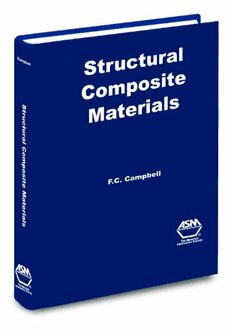
Structural Composite Materials PDF
629 Pages·2010·16.367 MB·English
Most books are stored in the elastic cloud where traffic is expensive. For this reason, we have a limit on daily download.
Preview Structural Composite Materials
Description:
This book deals with all aspects of advanced composite materials; what they are, where they are used, how they are made, their properties, how they are designed and analyzed, and how they perform in-service. It covers both continuous and discontinuous fiber composites fabricated from polymer, metal, and ceramic matrices, with an emphasis on continuous fiber polymer matrix composites.The book starts with an overview of composite materials and how highly anistropic composites differ from isotropic materials, such as metals. Some of the important advantages and disadvantages of composites are then discussed. The first chapter wraps up with some of the applications for advanced composites. Next, the reinforcements and their product forms are covered with an emphasis on glass, aramid, and carbon fibers. This is followed by a chapter on polymer matrix resin systems, covering the main thermosetting and thermoplastic resin systems, including polyesters, vinyl esters, epoxies, bismaleimides, cynate esters, polyimides, and phenolics. The principles of resin toughening are also presented, along with an introduction to the physiochemical tests that are used to characterize resin and cured laminates.The next part of the book covers polymer composite fabrication processes, with chapters on cure tooling, thermoset composite fabrication processes, and thermoplastic composites fabrication processes. Important thermoset lay-up methods include wet lay-up, prepreg lay-up, automated tape laying, fiber placement, filament winding, and pultrusion. Vacuum bagging in preparation for cure is also discussed along with the cure processes for both addition and condensation curing thermosets. Thermoset liquid molding covers preforming technology (weaving, knitting, stitching, and braiding) followed by the major liquid molding processes, namely resin transfer molding (RTM), resin film infusion (RFI), and vacuum assisted resin transfer molding (VARTM).In a chapter on thermoplastic composite fabrication processes, thermoplastic composite consolidation is covered along with the different methods of thermoforming thermoplastics. Finally, the joining processes that are unique to thermoplastic composites are discussed. After these processing fundamentals are set, there is a chapter that deals with some of the detailed processing issues unique to thermoset and thermoplastic composites. The concept of cure modeling is introduced along with the importance of both lay-up and cure variables, hydrostatic resin pressure, chemical composition, resin and prepreg, debulking, and caul plates. Residual cure stresses and exothermic reactions are also covered followed by methods for in-process cure monitoring.Adhesive bonding, sandwich, and integrally cocured structures are introduced in two chapters. The basics of adhesive bonding are covered along with its advantages and disadvantages. The importance of joint design, surface preparation, and bonding procedures are discussed along with honeycomb bonded assemblies, foam bonded assemblies, and integrally cocured assemblies.There is a chapter on the types, properties, and fabrication technology for discontinuous fiber polymer matrix composites, with an emphasis on spray-up, compression molding, structural reaction injection molding, and injection molding.In a chapter on assembly, the emphasis is on mechanical joining including the hole preparation procedures and fasteners used for structural assembly. Sealing and painting are also briefly discussed.The next four chapters cover the test methods and properties for composite materials. Nondestructive test methods include visual, ultrasonics, radiographic, and thermographic inspection methods. Mechanical property test methods include tests for both composite materials and adhesive systems. In the next chapter, the strength and st
See more
The list of books you might like
Most books are stored in the elastic cloud where traffic is expensive. For this reason, we have a limit on daily download.
